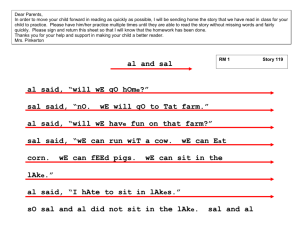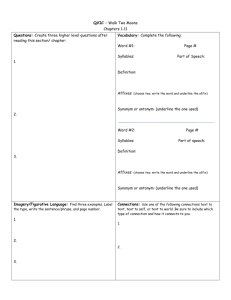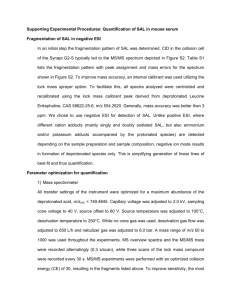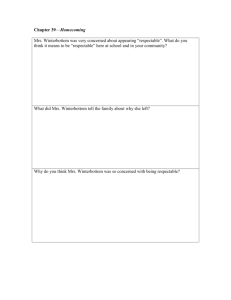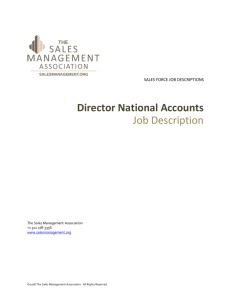Presentazione standard di PowerPoint
advertisement
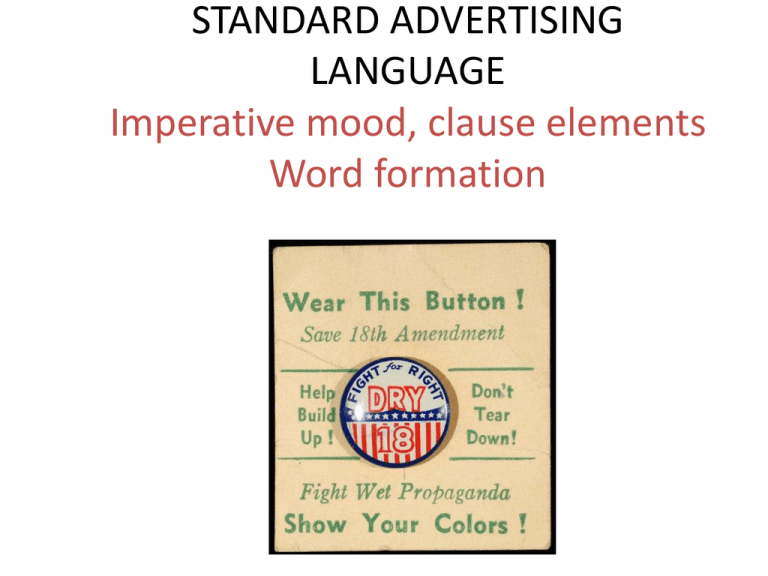
STANDARD ADVERTISING LANGUAGE Imperative mood, clause elements Word formation STANDARD ADVERTISING LANGUAGE (SAL) From now on, see Leech, English in Advertising – Chapters 11-22 Pennarola: Chapter 3 • Linguistic features that are unique in SAL • Linguistic features that are more frequently employed in SAL than in other registers SAL • FEATURES TO BE INVESTIGATED IN: – Clauses – Mood – Questions – Absence of subordination (minor/non finite sentences with disjunctive language) – Coordination – – – – – Cohesion / Lack of cohesion Verbal groups Nominal groups Words and compounds Vocabulary SAL – Clauses Imperative Mood • Higher occurrence of imperatives in SAL than in other registers. • They stir an active response • Used for three main reasons: – Product acquisition (addressed to the consumer): buy, choose, ask for – Product consumption / use: have, try, use, enjoy – Appeal for notice/fear (common in commercials of the demonstration type & to admonish or learn a lesson for the future – see Leech, p. 28): remember, make sure, see, look, watch Clauses: Imperative Mood Product acquisition vs Product consumption Appeal for Notice SAL – Clauses Interrogative MOOD • Questions are more frequent in INDIRECT address than in direct address • Questions require an answer BUT advertising is a one-way channel of communication • Why then asking questions? Because they stir a verbal response SAL – Clauses: Interrogative MOOD • YES/NO questions stir the expected answer according to the product • Ultimately, Yes/No questions are a special form or a sub-category of rhetorical questions. • Rhetorical questions are rarely used in SAL (though exceptions happen) • WH- questions are psychologically structured in problem/solution [i.e. headline/bodycopy] patterns; linguistically they are employed to make easier a sentence which otherwise would be complex SAL – CLAUSES: INTERROGATIVE MOOD Yes/No Questions SAL – CLAUSES: INTERROGATIVE MOOD Yes/No Questions SAL – CLAUSES: INTERROGATIVE MOOD Yes/No Questions SAL – CLAUSES: INTERROGATIVE MOOD Rhetorical Questions SAL – CLAUSES INTERROGATIVE MOOD Wh- questions • SAL – CLAUSES Minor/non-finite System • non-finite and minor clauses are a feature of disjunctive grammar; • They are independent. – The chief signal of clause subordination in English is given by the following: • An initial subordinating clause (why, when, if, whether, because, that, etc.) • parenthetical inclusion within another clause • intonation clues • punctuation clues SAL – CLAUSES Minor/non-finite System SAL – CLAUSES Minor/non-finite System • minor and non-finite clauses do not begin with a subordinate element • parenthetical inclusion does not occur in SAL • intonation and punctuation clues generally point to independent clauses. • In punctuation, the comma is rarely used; punctuation marks of greater separative force (as full stops, dashes, sequence of dots) predominate. SAL – CLAUSES Minor/Non-finite System • Non-finite & minor clauses have such simple grammar (no structure above the group) as to coincide with block language. • Particularly characteristic clauses are those whose initial adjuncts are prepositional phrases beginning with FOR SAL – CLAUSES Minor/Non-finite System • If the for phrase contains an abstract noun group, we have a benefit associated with the products: SAL – CLAUSES Minor/Non-finite System • When the for phrase contains a personal noun group, it denotes the potential beneficiary: SAL – DEPENDENT CLAUSES: WHEN, IF and BECAUSE • When is equivalent to whenever means: and – whenever X is used, Y is the result – whenever you want Y, use X • You is almost invariably the subject of the when clause. • The tendency is to have the dependent clause BEFORE the independent one SAL DEPENDENT CLAUSES: WHEN, IF and BECAUSE • In IF-clauses, there is a strong tendency to have the dependent clause BEFORE the independent • Reasons: – To single out the right category of consumers. – To make an initial bid for attention by appealing the consumer’s interest SAL DEPENDENT CLAUSES: WHEN, IF and BECAUSE • BECAUSE = giving a reason for buying the product. • The main meaning is ‘buy X. Because Y will be the result’. • position of the because-clause is always AFTER the independent one. • Whenever the copywriter wants to state the reason before the conclusion, the alternative version is given by so or that’s why SAL DEPENDENT CLAUSES: WHEN, IF and BECAUSE (examples) • Next time you pack his lunchbox pop in some cheese and an apple. Because men love cheese. • Men love cheese. So next time you pack his lunchbox pop in some cheese and an apple. • Men love cheese. That’s why next time you pack his lunchbox some cheese and an apple must be popped in. SAL Cohesion and Coherence «Clare loves potatoes. She was born in Ireland». • The two sentences are cohesive (Clare/she)…. • The pronoun provides a link with the proper noun Clare in the 1° sentence But they are only coherent if ……………. • Cohesion is only part of coherence in reading and writing. • Cohesion is a guide to coherence, which is something created by readers in the act of reading a text. • Coherence is the feeling that a text makes sense and that it is not a jumble of sentences. SAL Cohesion and Coherence «Clare loves potatoes. She was born in Ireland». • The two sentences are cohesive (Clare/she)…. • The pronoun provides a link with the proper noun Clare in the 1° sentence But they are only coherent if ……………. • Cohesion is only part of coherence in reading and writing. • Cohesion is a guide to coherence, which is something created by readers in the act of reading a text. • Coherence is the feeling that a text makes sense and that it is not a jumble of sentences. SAL: COHESION & COHERENCE • Meaning is conveyed thanks to cohesion and coherence. • In advertising language meaning is granted by cohesion, coherence and anchorage (a necessity as the texts intermingle with the visuals). • Main features of cohesion and coherence in SAL: • Coordination (even in those cases in which subordination better defines meaning) – apposition • Parataxis rather than a hypotaxis • Disjunctive and abbreviated grammar exploit the ‘lack’ of cohesion given by parataxis and apposition. COHESION & COHERENCE COORDINATION – A frequent type of coordination is apposition. – Apposition = coordination created by two noun groups, one of which - in the case of advertising – is the brandname: • Lifeguard. The disinfectant you trust completely. • Churchman’s Olympic Tipped. The cigarette that leads the way. – Apposition associates the brandname with a tag-line (sometimes the slogan) => positive image of the product. COHESION & COHERENCE COORDINATION – A frequent type of coordination is apposition. – Apposition = coordination created by two noun groups, one of which - in the case of advertising – is the brandname: • Lifeguard. The disinfectant you trust completely. • Churchman’s Olympic Tipped. The cigarette that leads the way. – Apposition associates the brandname with a tag-line (sometimes the slogan) => positive image of the product. SAL: COHESION & COHERENCE PARATAXIS • Parataxis is a technique that favours short, simple sentences, with the use of coordinating, rather than subordinating conjunctions. Why? Because the colloquial style is exploited by SAL: – No necessity of expressing the grammatical or lexical relations that allow the building of cohesion and coherence as speakers continually refer to their common-shared context. – context is provided by the visual (= common-shared context between the copywriter and the reader). COHESION & COHERENCE PARATAXIS (2) • The text is divided in smaller and more digestible units which can be better stored in the short term memory of the readers – thus facilitating readability. • We have a strong presence of the lexical repetition of the same item, usually the brandname – this for obvious reasons which may be lead to the concept of memorability. • Parataxis augments the feeling of genuine and nonpremeditated discourse (which is conveyed by linking). SAL - VERBAL GROUPS • Verbal groups consist of a single verb. • Auxiliaries are found rarely. • Present tense is always used even in those cases where the present continuous or the present perfect are required. • In this way the present is unrestricted and has a universal reference • Past tense is used in prestige ad only • Passive is never used. SAL - VERBAL GROUPS • Exceptions: CAN and WILL • WILL = PROMISE (consumer ads), a sort of conditional sentence with an unexpressed condition; • CAN = OPPORTUNITY & POSSIBILITY; – Subject • animate (YOU) - OPPORTUNITY, • unanimated subject & associated with the brand name - POSSIBILITIES. SAL VERBAL GROUPS WILL & CAN SAL VERBAL GROUPS WILL SAL - VERBAL GROUPS CAN Standard advertising language: Noun/Nominal Groups • • • • • • • The car The red car The bright red car The beautiful bright red car The new beautiful bright red car The almost new beautiful bright red car Dad’s almost new beautiful bright red car Standard Advertising Language: • NOUN GROUP • PRE-MODIFIER • • • • • • • The The red The bright red The beautiful bright red The new beautiful bright red The almost new beautiful bright red Dad’s almost new beautiful bright red • Premodifier: articles, adjectives, adverbs, substantives • Head: substantives HEAD car Standard Advertising Language Nominal groups: premodifiers • What is the purpose of pre-modifiers? • To add more information to the head, to univocally specify or identify the head, to avoid ambiguity Standard Advertising Language Nominal groups: premodifiers • In advertising language, we have: – Technical pre-modifiers – Attributive pre-modifiers – Mixed modifiers (because they are both attributive and designatives) – Product-name pre-modifiers Standard Advertising Language Nominal groups: premodifiers • Technical premodifiers: • Fantastic accelleration from the 95 b.h.p. Coventry Climax O.H.C. engine, more stopping power from the new 4-wheel servo assisted disc brakes and greater flexibility from the all synchromesh close ratio gearbox. These and many other new refinements combine to present the finest and fastest light G.T. car in the world – The technical caracteristics of the noun groups are indicated by premodifiers – They supply specifical details. – Typical of handbooks – This pre-modification compacts the discourse and gives a more specific description of the head as belonging to a category SAL: Attributive premodification • Glowing attractive description of the product. • Highly positively connoted adjectives such as : good, lovely, excellent (evaluative types). • Clusters of two adjectives = more emphatically emotive effect: – repetition of the same adjective (the wonderful wonderful Rome) – approbatory adjective + concrete adjective (this wonderful new toothbrush). – Typical of colloquial English (used by adults in addressing children). SAL: Mixed premodifiers • Cluster of two adjectives: – the first is evaluative, the second specifies the class of the product more specifically. – Examples: • • • • • Elegant tapered slacks Rugged western style jeans Snappy ankle flared beat jeans Natural germ-killing action A really first-class imported sherry • copywriters match praise/approbation with practicality. SAL: Product Nouns • Heavy premodification when frequent references to advertised product. • Reference by quoting: – the brandname • C2; Travelmate 290; 101 – the trademark • Citroen; Acer; Levi’s. – Type of the trademark/brandname product modified • Campbell’s Soup; Fray Benton Steak and Kidney Pie – the trademark + the brandname • Kraft Superfine Margarine • Carling’s Black label Canadian Lager by This is defined by Leech as Product Name Premodification. Usually, when the brand name is used as premodificator it is singled out from the rest by extra large fonts SAL: PREMODIFICATION Products Nouns • Sometimes, the brand-name-premodifier is BEFORE an adjective: – The Austin 55 sport cars gear level • In other cases, the brand name acts as a head – Liquid Bubbly Stergene PREMODIFICATION GENITIVES, COMPARATIVES & SUPERLATIVES, NOUN MODIFIERS • Genitives: refer to the manufacturer’s name • Comparatives and superlatives: augment positive and attributive features in the advertised products. • Noun modifiers: usually identified with the brand name. If not so, they have an emotive function (poetic licence) and no relation with their head: – Summer freshness; – Sunshine Flavour. SAL: New Words - Infixes • English = productive language • New words are coined with (1) infixes, (2) compounds. • Usually, the most common infixes employed by copywriters are: – the prefix super • superfine; superpractical; superlight – the suffix –y (widely used because it evokes an appeal by means of a reference to the sensible properties, flavour or texture, of the product) • crispy, creamy, bubbly, minty, crunchy, juicy, milky, nutty, porky, silky, spicy. SAL: New Words - Compounding • New words are formed through compounding. • A compound is a lexically restricted unit (noun group) in an embedded structure. • This means that a compound is a sequence of words acting as a single word. • The lexical constraints on compound formation are less stringent in advertising language than anywhere else. SAL: COMPOUNDS • Compounds as heads • The most productive and widespread compound head consists of two nouns: – Toothbrush; Bedtime. • In SAL, noun+noun compounds have a semitechnical meaning in describing the product, or the sphere of the human activity with which the product is associated: – cheese compartments; door shelves; ice tray; storage space; shelf area; colour freshness; jelly addict SAL: COMPOUNDS • Compounds as premodifiers: Adjectival compounds: First-class; brand-new; icy-cold; home-made; good-looking; hard-working Embedded noun groups High-fashion knitware; Wonderful freshmilk taste; Fuller-flavour fishsteaks; Happy-family menus; Any-time cereal; All-purpose garden fertilizer Embedded adjective groups A wholesome ready-to-eat cereal; Easy-to-paint picture Embedded adverbial groups All-around protection; Under-the-weather feeling Embedded verbal groups This eight-page pull-out booklet; Keep-it-up energy; Do-it-yourself kit THE NEW YEAR’S RESOLUTION DIET THE FIRST-REAL-DATEIN-TWO-YEARS DIET THE WEDDING DAY DIET THE HONEYMOON DIET THE IT-CAN’T-BE-SUMMERI-HAVEN’T-LOSTANY-WEIGHT-YET DIET THE I-WISH-I-WAS-HER DIET THE BEFORE-THE-BABY DIET THE AFTER-THE-BABY-DIET THE IF-FERGIE-CANLOSE-IT-SO-CAN-I DIET SAL: VOCABULARY • The 20 most commonly used adjectives are: • 1. New 11. crisp 2. good/better/best 3. Free 4. Fresh 5. Delicious 6. Full 7. Sure 8. Clean 9. Wonderful 10. Special 12. fine 13. big 14. great 15. real 16. easy 17. bright 18. extra 19. safe 20. rich SAL Vocabulary: adjectives (2) • new, good, better, best = commonly used, but not very often – general all-purpose meaning • wonderful, fine, great = general commendation • delicious, crisp, fresh, rich = generally used associated with food • Fresh, clean = toothpaste; clean also with shampoo, detergents, etc • sure = connected with humans • sure/clean = connected with hygiene • extra/special = similar to new, express uniqueness • nice, lovely, marvellous = common in indirect address SAL Vocabulary: Verbs • The twenty most frequent verbs: • 1. Make 2. Get 3. Give 4. Have 5. See 6. Buy 7. Come 8. Go 9. Know 10. Keep 10. look 12. need 13. love 14. use 15. feel 16. like 17. choose 18. take 19. start 20. Taste • Features: monosillabic, colloquial and from Germanic SEMANTICS: UNIQUENESS OF REFERENCE & UNIVERSALITY OF REFERENCE • Copywriters seem to speak to each of us and not to the mob (UNIQUENESS OF REFERENCE). • How? Using: – YOU – THE – THAT (sometimes SUCH or SO) • Be THE girl with the Bush. Beautiful. Clever.The perfect partner. • A green Shield Worthington gives every man THAT great feeling • SUCH a goot natural Cheddar • Fresh daisy cream tastes SO good SEMANTICS: UNIQUENESS OF REFERENCE & UNIVERSALITY OF REFERENCE (2) • Uniqueness is accompanied by adjectives of positive universal meaning such as ALL, EVERY, EVERYONE, ALWAYS – Its instant germ-killing action kills ALL germs twelve times faster – There’s a fertilizer for EVERY crop – She ALWAYS uses Kraft Superfine Margarine – EVERYONE loves Hartley’s Jam SEMANTICS: UNIQUENESS OF REFERENCE & UNIVERSALITY OF REFERENCE (3) • Universal negators (No, Never) are seldom used. • When they are, they occur in a sentence with a further negative implication that has the effect of uncompromising positiveness: – NEVER go to be with a cold without decongestant Vick vapor Rub
